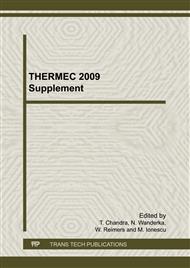p.586
p.592
p.598
p.604
p.609
p.615
p.621
p.627
p.633
Evolution of Residual Stress in Cu-Line Patterns with Different Linewidth
Abstract:
The Cu-line patterns with different linewidth were deposited by radio-frequency sputtering and defined by photolithography lift-off process. The residual stress was evaluated with X-ray diffraction technique and the results show that the Cu-line patterns are in a biaxial stress state and the stress values have a great dependence on linewidth. Further analysis reveals that the intrinsic stress has a main effect on changes of residual stress; however, the thermal stress plays a key role on anisotropic contribution of residual stress in directions along and across the Cu line. The variation of intrinsic stress correlates well with crystal orientation of the Cu line, and the linewidth seems to be the most crucial parameter for evolution of both texture and stress.
Info:
Periodical:
Pages:
609-614
Citation:
Online since:
January 2010
Authors:
Price:
Сopyright:
© 2010 Trans Tech Publications Ltd. All Rights Reserved
Share:
Citation:


